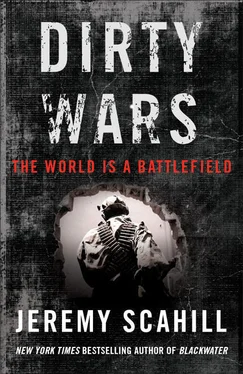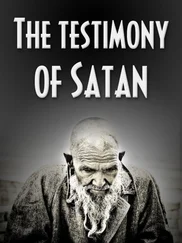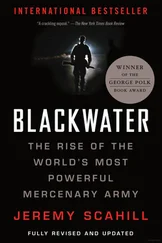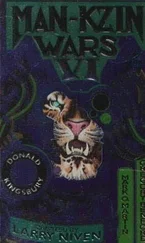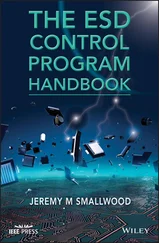As the new kill/capture program began to kick into full gear in late 2001, the CIA’s number-three man at the time, Buzzy Krongard, declared the “war on terror” would be “won in large measure by forces you do not know about, in actions you will not see and in ways you may not want to know about.” A US official directly involved in rendering captives told the Washington Post, “We don’t kick the (expletive) out of them. We send them to other countries so they can kick the (expletive) out of them.” Another official who supervised the capture and transfer of prisoners told the paper, “If you don’t violate someone’s human rights some of the time, you probably aren’t doing your job,” adding, “I don’t think we want to be promoting a view of zero tolerance on this. That was the whole problem for a long time with the CIA.” Cofer Black put a fine point on it when he told Congress about the new “operational flexibility” employed in the war on terror. “This is a very highly classified area, but I have to say that all you need to know is that there was a before 9/11, and there was an after 9/11,” Black said. “After 9/11 the gloves come off.”
The early stages of the post-9/11 rendition program began what would be a multiyear battle between the FBI and the CIA over who would take the lead in investigating the terror attacks. It would also bring to the surface how little regard the Bush White House had for anything vaguely resembling a law enforcement approach to the perpetrators of 9/11. As the Taliban regime crumbled and US troops poured into Afghanistan, scores of al Qaeda operatives began retreating across the border into Pakistan. In November, Pakistani forces picked up al Qaeda trainer Ibn al Shaykh Libi, who allegedly ran the Khalden training camp in Afghanistan where the would-be “Shoe Bomber,” Richard Reid, and Zacarias Moussaoui, the so-called Twentieth Hijacker, were both trained. The Pakistanis handed Libi over to FBI agents stationed at Bagram Air Base for questioning. The FBI saw the prisoner as a potentially valuable source of intel on al Qaeda and a possible witness against Moussaoui. New York–based FBI agent Jack Cloonan told his agents in Afghanistan to “handle this like it was being done right here, in my office in New York.” He said, “I remember talking on a secure line to them. I told them, ‘Do yourself a favor, read the guy his rights. It may be old-fashioned, but this will come out if we don’t. It may take ten years, but it will hurt you, and the bureau’s reputation, if you don’t. Have it stand as a shining example of what we feel is right.’” Libi’s interrogators described him as cooperative and “genuinely friendly” and said that he had agreed to give them information on Reid in return for promises to protect his family.
However, just as the FBI believed it was making headway with Libi, CIA operatives, on orders from Cofer Black, showed up at Bagram and demanded to take him into their custody. The FBI agents objected to the CIA taking him, but the White House overruled them. “You know where you are going,” one of the CIA operatives told Libi as he took him from the FBI. “Before you get there, I am going to find your mother and fuck her.”
The CIA flew Libi to the USS Bataan in the Arabian Sea, which was also housing the so-called American Taliban, John Walker Lindh, who had been picked up in Afghanistan, and other foreign fighters. From there, Libi was transferred to Egypt, where he was tortured by Egyptian agents. Libi’s interrogation focused on a goal that would become a centerpiece of the rendition and torture program: proving an Iraq connection to 9/11. Once he was in CIA custody, interrogators pummeled Libi with questions attempting to link the attacks and al Qaeda to Iraq. Even after the interrogators working Libi over had reported that they had broken him and that he was “compliant,” Cheney’s office directly intervened and ordered that he continue to be subjected to enhanced interrogation techniques. “After real macho interrogation—this is enhanced interrogation techniques on steroids—he admitted that al Qaeda and Saddam were working together. He admitted that al Qaeda and Saddam were working together on WMDs,” former senior FBI interrogator Ali Soufan told PBS’s Frontline. But the Defense Intelligence Agency (DIA) cast serious doubt on Libi’s claims at the time, observing in a classified intelligence report that he “lacks specific details” on alleged Iraqi involvement, asserting that it was “likely this individual is intentionally misleading” his interrogators. Noting that he had been “undergoing debriefs for several weeks,” the DIA analysis concluded Libi may have been “describing scenarios to the debriefers that he knows will retain their interest.” Despite such doubts, Libi’s “confession” would later be given to Secretary of State Powell when he made the administration’s fraudulent case at the United Nations for the Iraq War. In that speech Powell would say, “I can trace the story of a senior terrorist operative telling how Iraq provided training in these weapons to al Qaeda.” Later, after these claims were proven false, Libi, according to Soufan, admitted he had lied. “I gave you what you want[ed] to hear,” he said. “I want[ed] the torture to stop. I gave you anything you want[ed] to hear.”
The pattern that was emerging early on with the rendition and interrogation program centered on two primary objectives: dismantling al Qaeda’s network and preventing any further attacks, and supporting the case for an invasion of Iraq. In pursuit of these goals, no options or tactics would be left off the table. While the State Department cautioned against declaring an ill-conceived global war and pushed for a narrow, law-enforcement response to 9/11, Cheney began drawing up plans for ambitious global kidnapping and assassination operations in which certain elements of the CIA would initially take a leading role. Cheney, according to former senior CIA and State Department officials, began effectively directing a global manhunt using a mesh of Special Operations Forces and operatives from the CIA’s Special Activities Division, the paramilitary arm of the Agency. The former officials described a culture that permeated these operations in which ambassadors, the conventional US military commanders and even CIA station chiefs around the world were kept in the dark about clandestine or covert activities. To execute this program, Cheney relied on the gray area in US law and command authority between the jurisdiction of the CIA and the military.
In November 2001, Cheney convened a meeting at the White House to put the finishing touches on a presidential order, drawn up by Addington and other lawyers, that outlined how prisoners captured around the world would be tried. As had become custom, War Council lawyers were invited to the meeting, but senior State Department and National Security Council officials were shut out. Powell and the State Department’s lawyers had told President Bush that they believed that, under the Geneva Convention, Taliban and al Qaeda detainees were entitled to legal protections and humane treatment while in enemy custody. They furthermore warned that in not offering America’s enemies such protections, it would endanger the lives of US military personnel captured in the war. On February 7, 2002, President Bush made his decision. He signed another directive, based on a notion that the Geneva Convention was “quaint” and did not apply to al Qaeda or Taliban prisoners held by the United States. The order was issued just after the Bush administration began sending detainees snatched in Afghanistan and elsewhere to a US military prison at Guantánamo Bay, Cuba.
Although Congress was largely asleep at the wheel in its oversight responsibilities early on in the war on terror, the administration knew that would not last. By early 2002, some on Capitol Hill were already demanding that the CIA and administration brief them on the range of tactics being used by the Agency in pursuit of terror suspects. The full details of how those early post-9/11 “Cheney Program” operations were run and who exactly was operating them will likely never be fully revealed. “We deliberately kept the circle of people who knew where the black sites were to a very small number. We didn’t tell the FBI,” recalled Rodriguez, the CIA official who coordinated the construction and use of the black sites. “Many people, even those within the Agency with the highest security clearances, were not clued in. As far as I know, the location of the black sites was not even shared with the president.” Rodriguez added that it was not that those senior officials kept outside the circle of knowledge were untrustworthy, “but rather that they simply did not have a ‘need to know.’”
Читать дальше
